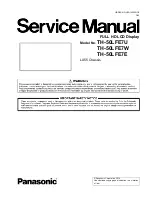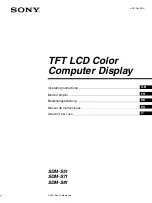
4
TH-50LFE7U/TH-50LFE7W/TH-50LFE7E
1.3.
Touch-Current Check (for TH-50LFE7W/TH-50LFE7E)
1. Plug the AC cord directly into the AC outlet. Do not use an isolation transformer for this check.
2. Connect a measuring network for touch currents between each exposed metallic part on the set and a good earth ground
such as a water pipe, as shown in Figure 1.
3. Use Leakage Current Tester (Simpson 228 or equivalent) to measure the potential across the measuring network.
4. Check each exposed metallic part, and measure the voltage at each point.
5. Reserve the AC plug in the AC outlet and repeat each of the above measure.
6. The potential at any point (TOUCH CURRENT) expressed as voltage U
1
and U
2
, does not exceed the following values:
For a. c.: U
1
= 35 V (peak) and U
2
= 0.35 V (peak);
For d. c.: U
1
= 1.0 V,
Note:
The limit value of U
2
= 0.35 V (peak) for a. c. and U
1
= 1.0 V for d. c. correspond to the values 0.7 mA (peak) a. c. and 2.0
mA d. c.
The limit value U
1
= 35 V (peak) for a. c. correspond to the value 70 mA (peak) a. c. for frequencies greater than 100 kHz.
7. In case a measurement is out of the limits specified, there is a possibility of a shock hazard, and the equipment should be
repaired and rechecked before it is returned to the customer.
Summary of Contents for TH-50LFE7W
Page 15: ...15 TH 50LFE7U TH 50LFE7W TH 50LFE7E 6 1 3 LCD Panel test mode ...
Page 16: ...16 TH 50LFE7U TH 50LFE7W TH 50LFE7E ...
Page 27: ...TH 50LFE7U TH 50LFE7W TH 50LFE7E 27 8 Block Diagram 8 1 Diagram Notes ...
Page 31: ...31 TH 50LFE7U TH 50LFE7W TH 50LFE7E 9 Wiring Connection Diagram ...
Page 33: ...33 TH 50LFE7U TH 50LFE7W TH 50LFE7E 10 2 Packing and Accessories ...


























